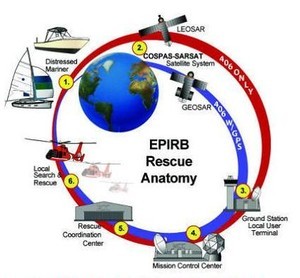Satellites Rescue 353 in USA alone in 2007
by NOAA on 19 Jan 2008

The Process SW
'Don't leave home without your PLB (Personal Locator Beacon) but make sure it is a 406' - that's the message from the National Oceanic and Atmospheric Association (NOAA), whose satellites located 353 people for rescue organisations in 2007 - in the USA and its surrounding waters alone.
Armed with the PLB's to send a distress signal, the 353 people were rescued in the United States and its surrounding waters from potentially life-threatening emergencies. These signals were transmitted to rescue teams via a NOAA environmental satellite more commonly known for providing information to weather forecasters.
NOAA’s polar-orbiting and geostationary satellites, along with Russia’s Cospas spacecraft, are part of the high-tech, international Search and Rescue Satellite-Aided Tracking System, called COSPAS-SARSAT. This system uses a network of satellites to quickly detect and locate distress signals from emergency beacons on board aircraft and boats and from handheld personal locator beacons (PLBs).
Now in its 25th year of operation, COSPAS-SARSAT has been credited with more than 22,000 rescues worldwide, including more than 5,700 in the United States and its surrounding waters.
“Each person rescued was a tragedy averted,” Mary Kicza, assistant administrator for NOAA's Satellite and Information Service. “This satellite-based rescue program is a key NOAA contribution to protecting American lives.”
SARSAT satellite.
When a satellite pinpoints a distress location within the United States, or its surrounding waters, the information is relayed to SARSAT Mission Control at NOAA’s Satellite Operations Center in Suitland, Md., and then sent to a Rescue Coordination Center, operated either by the U.S. Air Force, for land rescues, or U.S. Coast Guard, for water rescues.
Alaska and Florida recorded the most rescues in 2007 – 73 each. North Carolina was third with 16 rescues. Twenty-four states experienced a SARSAT rescue. Of the 353 rescues for 2007, 235 people were saved at sea, 30 were rescued from downed aircraft, and 88 were saved with help from their PLBs — the highest total since PLBs became operational nationwide in 2003. The total rescues in 2007 mark an increase from 272 the previous year.
“Anyone with plans to hike, or camp, in a remote area, where cell phone service is not reliable, or sail a boat far from shore, should not leave home without an emergency locator beacon, registered with NOAA,” said Chris O’Conners, acting program manager for NOAA SARSAT. He added the number of beacon registrations in 2007 climbed to 29,710 compared with 23,383 in 2006.
Urgency Noted in Changeover to 406 Frequency
Older emergency beacons, which operate on the 121.5 and 243 megahertz frequencies, will be phased out by early 2009, when 406 megahertz beacons will become the new standard. A key advantage of some the 406 megahertz beacons is they use Global Positioning System technology for instant detection, leading to faster rescues.
All of the rescues in 2007 from emergency locator transmitters carried on planes, used the older 121.5 MHz frequency. But beginning February 1, 2009, this 121.5 MHz signal will not be processed. “It’s critical that everyone gets the message now to make the switch to the 406 MHz beacons,” added O’Conners.
2007 SARSAT Rescue Highlights in the USA
Four people were rescued in Lake Michigan, when a powerful storm knocked out communications to their boat, which was running low on fuel.
Near Kanatak, Alaska, four people and a dog were pulled to safety from their sinking boat;
Three people were rescued after their raft capsized in the rough rapids of the Green River in northeast Utah.
A U.S. Coast Guard helicopter hoisted three people from 70-foot high seas, after their boat sank 200 miles off the coast of North Carolina.
A 71-year-old hiker, too exhausted to continue his outdoor trek along the Pacific Crest Trail, was rescued in Wrightwood, Calif.
The National Oceanic and Atmospheric Administration, an agency of the U.S. Commerce Department, is dedicated to enhancing economic security and national safety through the prediction and research of weather and climate-related events and information service delivery for transportation, and by providing environmental stewardship of our nation's coastal and marine resources.
Through the emerging Global Earth Observation System of Systems (GEOSS), NOAA is working with its federal partners, more than 70 countries and the European Commission to develop a global monitoring network that is as integrated as the planet it observes, predicts, and protects.
If you want to link to this article then please use this URL: www.sail-world.com/41021